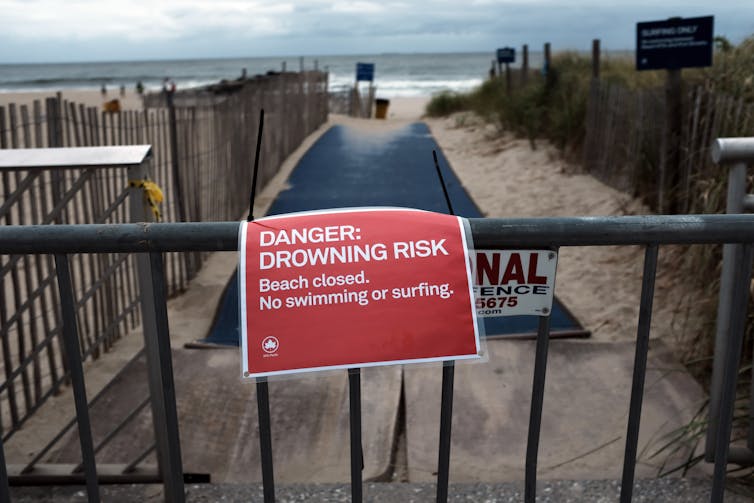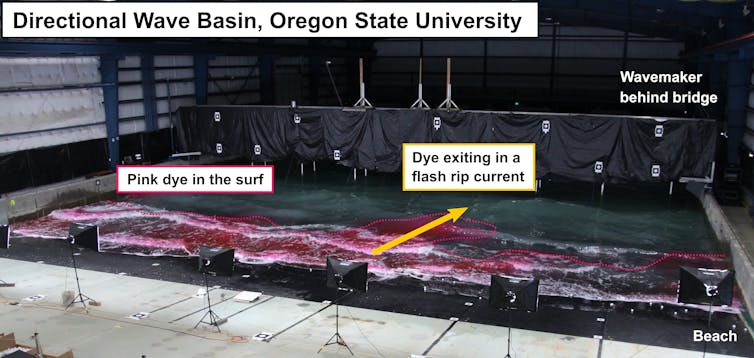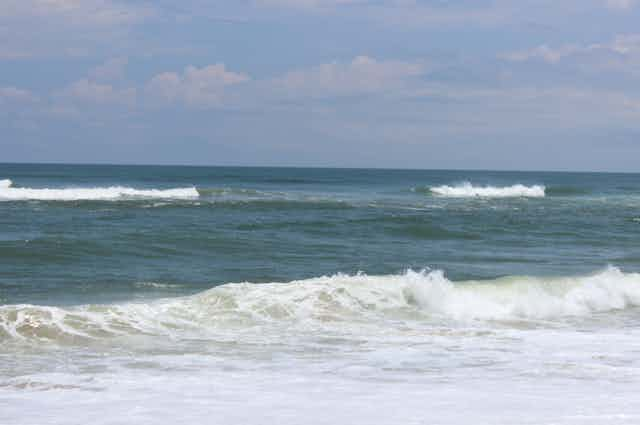If you’ve ever waded into the ocean for a swim and suddenly realized that the shore is getting farther away, not closer, you may have encountered a rip current. Common at beaches worldwide, these powerful currents flow from the shore toward the sea at speeds up to several feet per second.
It’s important to know what rip currents are and how to look for them, because they are a leading cause of drownings in the surf zone near shore. According to one recent estimate, rip currents have accounted for 435 drownings in the U.S. since 2017.
National Weather Service offices that serve coastal communities issue forecasts that predict where and when rip currents are likely to occur. Those forecasts draw on decades of research into the physics of rip currents. Many scholars, including our research group, are finding innovative ways to discover more about rip currents – including their important roles in coastal marine ecosystems.
Not all rip currents are the same
All rip currents have similar effects, but they can form in several ways.
One type of rip, known as a bathymetric or channel rip current, forms when there are gaps between breaking waves. As waves break, they push water toward the beach and raise the level of the water slightly.
If waves break on a sandbar, but not in a deeper channel that cuts through the sandbar, the extra water that the waves have pushed toward the beach escapes back to the ocean through the channel. The flow of the escaping water acts like a conveyor belt, moving water, unsuspecting swimmers and small marine organisms offshore.
Another type, known as a transient or flash rip current, forms when surf is choppy. The edges of breaking waves push on the water and make it spin, like a fast ice skater bumping into someone.
This creates whirls known as eddies, which can combine to form larger whirls, with currents that act like temporary conveyor belts. Flash rip currents are an active area of research.
Swim, float, call for help
Choosing beaches with lifeguards and paying attention to beach flag warnings are the best ways to avoid rip currents. However, if you get caught in one, here are some techniques for getting safely back to shore.
Think of a rip current as a swift river cutting through the surf away from the shore. Swimming against the current is going to tire you out and put you at risk of drowning. Instead, swim parallel to the beach – think of heading for the “river banks” – until you are out of the rip current’s pull. Once you’re no longer fighting it, you can swim back to shore.

Another strategy is to float until the rip current carries you offshore beyond the breaking waves. Rip currents slow down here, so you can swim away from the rip current and back to shore.
If you believe you’re in danger, try to stay calm. Wave your arms and call for help. If you see someone caught in a rip current, throw them a flotation device and alert a lifeguard.
Forecasting rip currents
The National Oceanic and Atmospheric Administration’s rip current hazard model provides advance forecasts of the likelihood of encountering hazardous rip currents given wave conditions at specific beaches. NOAA works continually to make these hazard forecasts more accurate, including through an ongoing partnership with the U.S. Lifesaving Association. This partnership works to compare modeled predictions with lifeguard reports of rip current hazards and to recalibrate the model for different regions and waves.
At the University of Washington, we are evaluating NOAA hazard forecasts against the latest rip current science. This helps us assess predictions for different types of rip currents, such as unexpected flash rips.
To measure rip currents, we sometimes put on scuba gear and battle the waves to set up instruments in the surf. But this work can be expensive, and it relies on knowing where rips will occur beforehand. That isn’t possible for flash rips, so we need different methods to analyze those.
We use supercomputers and massive wave tanks the size of an Olympic swimming pool, with paddles at one end that produce waves, to simulate flash rips. Wave tank laboratory experiments and computer simulations allow us to control the types of waves we produce and make it easier to collect a lot of data. This work is improving our understanding of the relationship between wave conditions and flash rips, which can help improve hazard predictions.

Expressways for marine life
Rip currents aren’t just a safety issue. Scientists are beginning to better understand the crucial ecological role they play in redistributing small marine organisms, as well as plastic, pollutants, sediment and debris in coastal waters.
Many marine organisms, including oysters, barnacles, fish and coral, rely on ocean currents during their larval stage to find suitable habitats. These organisms swim up or down or attach to floating or sinking material and are transported by multiple ocean processes.
Rip currents are a key mechanism for dispersing larvae to deeper waters or recirculating them in shallow waters. The rip current type and behavior may affect the movement of marine organisms.
Water temperature and salinity can change the behavior of rip currents – and send organisms on alternate routes – by modifying the water’s density. Our group has analyzed imagery taken from low-flying planes and found that warmer rip currents carry water farther offshore at the surface, whereas cooler rip currents spread beneath the surface in different patterns.
Our research group and other scientists are using computer simulations and numerical “larvae” to investigate how temperature, salinity and other factors may affect transport of marine organisms. With better understanding of these surf-zone conveyor belts, we aim to help keep swimmers safe and assess how rip currents affect aquatic ecosystems near the shore.

